Need Mail bonding?
Go to the Yahoo! Mail Q&A for great tips from Yahoo! Answers users.
The following are sketches into my dreams and waking life while being on the road in South Asia. I was there working for six months during the winter of 2005-2006. My travels, often alone, took me into places of darkness to follow the sweetness and the fragrance of my own self-discovery. How do we navigate through life, around the obstacles of our existence, to find flow, joy, and the wide open expansive light that is the very ocean within ourselves? Welcome and enjoy! More at www.rakuloren.com


Thank you for taking the time.
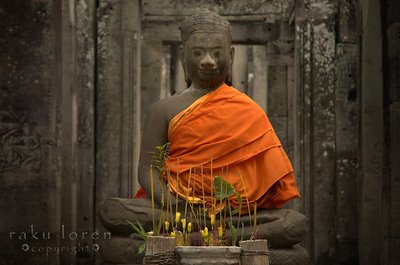 A Buddha statue at an entrance to an acient temple in northern Cambodia.
A Buddha statue at an entrance to an acient temple in northern Cambodia.
She had to move up to my seat because a couple just got on and they wanted to sit together, maybe to support each other on what all of us had read in our various guidebooks, was to be one of the worst main roads in Asia. We were on our way out of Cambodia, back to Thailand.
 Divine inspiring divine at a temple in northern Cambodia.
Divine inspiring divine at a temple in northern Cambodia.
The temperature was to get into the upper nineties today and our minibus had no air conditioning – of course as it was supposed to. We all paid extra for the tourist bus thinking it would be more comfortable than less expensive options. Everywhere that sold tickets said, “Yeah, air conditioning, this is the picture of your bus.” They would point to a color photography of a shiny new luxury bus. When one has traveled in Asia long enough, promises like these are far from legally binding. We just had no idea the bus would be as bad as it was. Some people wanted their money back after seeing it.
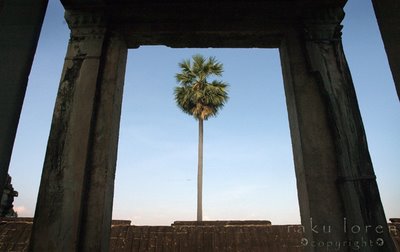
But there was nothing we could do unless we wanted to march back to a guesthouse with all of our stuff and wait to see how the bus tomorrow looked. When I saw the outside of the bus – I knew – a working air conditioning system was going to be highly unlikely on this thing and that it appeared that the bus needed so many other repairs that air conditioning had a yeah right kind of importance to it. Maybe it was because when it got closer and pulled up to where we are waiting, with open windows, that was the big clue. It’s weight without any passengers was already heavy on one side, the entire body was scratched and dented, and it looked like it had been pretty much entirely hammered out from fender (and door and side) benders. It looked like it had been driven around the world -- several times. It looked like they had imported it in from Afghanistan. Had it been rolled? I was looking to the roof, looking for any big dents before I made my final decision to get on or not. Nothing screamed out at me – just an unplaced, nearly inaudible hiss. I relegated that do the radiator and climbed on. 
She moved up to my seat and that’s where we met. We didn’t formally introduce ourselves and while we talked and talked, I think, with the more time that went by, we both felt a little silly asking, “Umm, what’s your name anyway?!”
 Stone blocks, temple wall, northern Cambodia.
Stone blocks, temple wall, northern Cambodia.
The first half hour of the drive was pretty good. I was wondering if the guidebook was wrong on yet another fact. Then, WHAM! The pavement stopped and dirt moguls began. Our driver was taking them like he was on a slalom course. After an hour of this madness, looking around, through a cloud of red dust, seeing people holding whatever material they could find, bunched up over their mouth and nose. A few were holding their hands over their mouths. I chuckled, After an hour of this madness, looking around, through a cloud of red dust, seeing people holding whatever material they could find, bunched up over their mouth and nose. A few were holding their hands over their mouths. I chuckled, yeah, that’s gonna filter everything out! A few others were bent over. I wasn’t looking for details. We were all bouncing off our seats as we hit the bumps.
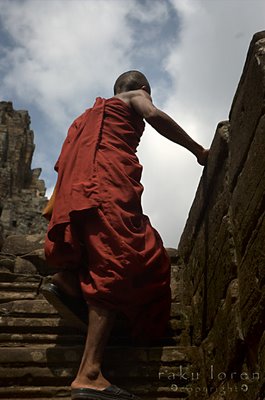 A monk climbs the steps into a temple, northern Cambodia.
A monk climbs the steps into a temple, northern Cambodia.
The windows were rattling hard. They were self-opening with the vibration. The noise from the shaking of glass and metal was like being at a rock concert – except it was one long drum solo. Red dust from dirty clay road streamed into the bus constantly, kicked-up from the trucks in front of us. On the one hand, we all despised the dust and would have just kept windows closed but it was so stifling hot in that little oven-on-wheels that we kept the windows a little open, thus suffering from both hardships because all of one would have been probably worse.
I made the mistake that morning of putting on a clean white shirt. It was now quickly turning red especially on the window side and where I was perspiring –everywhere—the shirt was red and wet and I knew this was the end of this shirt, that it would never look clean again.
I turned to her with a smile that said, can you believe this? She shook her head and said, “Yeah, and there’s supposed to be two more hours of the same!” In that moment, I dropped whatever was covering my airways and let my jaw slacken down so it was near resting in my lap. “No way!” “Well, that’s what the book says.” We both scrunched our brows up and resumed the one hand on the dust mask, the other hand on the seat in front of us position.
Through hardship we found communion. And so for the next ten hours, we traveled together, still, we didn’t know each other’s names.
We got into Bangkok and were walking down the street together when I stopped her and said, “We’ve been traveling for ten hours together, from one country to another, on one amazingly bad road and now we’re going to share a room for a few nights -- umm, what’s your name anyway?” We had a good laugh about this.
 Moments before the rain began to fall, the storm rolling in was spectacular, southern Cambodia.
Moments before the rain began to fall, the storm rolling in was spectacular, southern Cambodia.
It’s like that when you’re traveling. You’re always meeting people, talking to people. Often, names go into one ear and out the other. Interactions are often so fleeting – and you never know how long you will know that person – that names often come later. In this case, a lot later!

My yoga meditation, sunset, southern Cambodia.

I had just gotten a couple of books from a shop just down the street from my hotel. The shop keeper had brought out a couple more that he thought I might like and I was perusing when I looked over my shoulder – I felt a new presence. It was water pouring from the sky in such force it was bouncing off the ground and raining upwards again. In such a circumstance, I normally would just cozy-in somewhere undercover, wait it off, hold onto a warm glass of chai. But I remembered something that was going to disrupt any idea I had of staying dry.

On seeing the sun this morning, laundry became a focal point of the day’s activities – one never knows when the next offering of dry, warm sky will be. And so with many other like-minded folks on rooftops far and wide, we hung our pants, shirts, socks, and saris. In two moments, I thanked the bookseller, rubbed my fists together and pointed up to the top of the building and then to the rain coming down. He understood and in two steps, I was on the sidewalk taking a half-moment to psyche up for the mad dash back to my hotel.
Street vendors were frantically pulling tarps out to blanket over piles of their books, fruits, clothes, and wares. All around me people were scurrying about. Everyone was running for cover with either a fearful grimace that contorted their faces or with one which seemingly recognized the cosmic joke that all of this was. I thought of the scene just outside of an ant hole in the garden after the sprinklers come on. That’s us right now!
I leaped off the curb and made the forty yard dash to my hotel. In these first few moments that the rain falls, people are frantic to stay dry. It’s the kind of rain that is so thick, it can soak you in no time at all. Everyone is running, hunched over, holding whatever object is convenient over their heads, high-stepping to keep the sandals on their feet on. On my way, I am dodging and spinning around parked rickshaws and possible tackles from people on moving scooters who are also scurrying – at high speed – and whose only vision is from the squint in their eyes, the scrunched faces apparently keeping them somewhat drier than a relaxed face. I am also trying to keep my sandals on. I arrive at my guest house and am sprinting up five flights of stairs to the rooftop where my nearly dry clothes are no longer nearly dry. The rain is crashing down and I am trying to expediently untie my clothes from the lines. Now I am the one squinting, rain streaking down my forehead to my brow. I collect everything, pack it under my arm and dash back in for cover. I’ve made it.
I arrive at my guest house and am sprinting up five flights of stairs to the rooftop where my nearly dry clothes are no longer nearly dry. The rain is crashing down and I am trying to expediently untie my clothes from the lines. Now I am the one squinting, rain streaking down my forehead to my brow. I collect everything, pack it under my arm and dash back in for cover. I’ve made it.
Then I look down at the clothes I am wearing; I wonder what clothes I was trying to save from getting wet! The absurdity of all of this – Ha!
 From a Bengali movie poster. Are those women running out of the surf carrying machine guns?!
From a Bengali movie poster. Are those women running out of the surf carrying machine guns?!
From a Calcutta Metro Do and Don’t list inside the train car, along with where to stand and directions on what to do in case of emergency:
“Please avoid listening to and spreading rumors.”
and another,
“Metro cares for you. Please do not get panicky.”
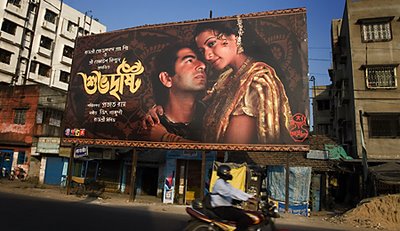
street billboard
“100% virgin plastic.”
From a big round sticker on a plastic bucket outside of a chai stall near my hotel that I go to in the mornings.
 Political sign painted on the outside of someone's house. Rickshaws parked out in front. Notice the drawing of the traditional style boat near the door way.
Political sign painted on the outside of someone's house. Rickshaws parked out in front. Notice the drawing of the traditional style boat near the door way.
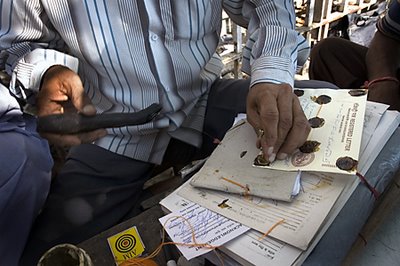
Outside of post offices, there are people selling envelopes and pens, those who will wrap a parcel with the obligatory cotton fabric and than stitch it together with needle and thread, there are notaries, there are men with type writers on little wooden tables who can make something look official or transcribe something into Hindi or English but mostly to write for those who never learned how, there are others like this man who will seal the seams of a letter or a parcel with wax stamps to ensure it arrives untampered with.
and
Lung Fung
The name of a Chinese restaurant that I am pretty sure I don’t want to eat at!

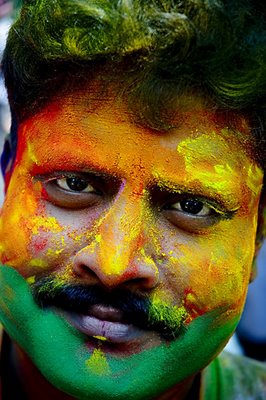
And so on this day of festivities, most of Hindu India celebrate in one of their favorite festivals; it’s called Holi. I pretty much new what to expect around the tourist ghettos: all of the workers in the area that had to serve the jerks and air heads from the last twelve months finally had license to let off some steam with probable group ambushes using special force like choreography all in the name of a little fun and celebration – yeah right, that will be a lot of fun. I knew it would not be fun for everyone for very long so I decided well in advance that I would be somewhere else on that particular day.
I asked several people where they thought I should go for Holi. “Where will people really be celebrating in a very Indian way?” is what I would ask. A village several hours away called Shantiniketan kept coming up. Besides several hours of travel, I would have to leave several hours earlier than I normally wakeup to ensure that I arrive for the climax of the festivities, in the morning. But because the name of this village kept coming up, I thought it must be a sign; the same recommendation from all of these people, I must go. And so I did.
Not long after my arrival there, I realized that the fear I had had of being at the center of a lot of unwanted attention wasn’t just some unfounded fiction and it wouldn’t be quite so easy to dodge. It was real and it would prove to manifest itself in a variety of forms. Here, it wasn’t just what the lightness of my skin color represented, I attracted an excessive amount of attention because I was one of the few non-Indians there, in this little village, I really stood out and so people would stop what they were doing – and I would see this over and over, turn towards me as they elbowed their friends around them and then begin to converge on me like walking Frankensteins . I felt like I was in some strange Indian zombie movie. Attack of the jolly Hindus!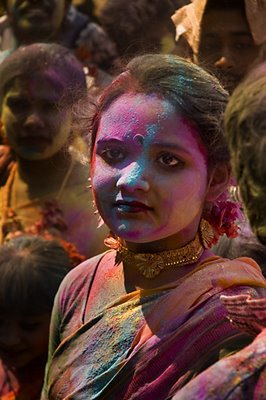
People from all around had made a pilgrimage to this village famous for it’s University named after the beloved renaissance poet/writer/playwright/musician Rabindranath Tagore. There seemed to be plenty of merriment all around even with the traffic of rickshaws taking people to and from the campus that had open-air classrooms and many large shady trees.
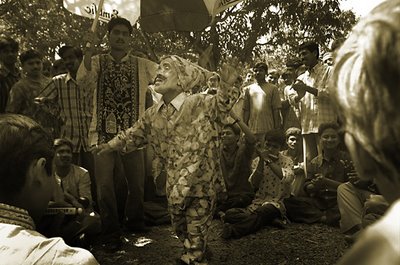
Yes, everyone seemed to be celebrating with playful vigor but my presence convinced me that I must have something that resembled a small disco ball attached to the top of my head. My being there caused heads to turn and feet to move – towards me – with clenched fists full of powdered dyes of radiant hues. There was always the convivial wide, full tooth smile and the “Holi hai!” or “Happy holi!” After a while, my first mental reflex was the second of a three part experience. Just after their eyes met mine and the switch of my seemingly electromagnetic pull turned on, I would think, “Yeah right! Here we go – again.”
One would begin by politely smearing a colorful powdered dye on my forehead, cheeks, and anywhere else on my face that hadn’t already been tagged. Then I would feel the tumbling drizzle of powder falling down my back, between my white shirt and my sweating skin. Everyone had to have their turn with me. 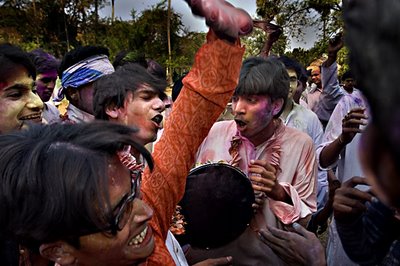 Each with an overly-enthusiastic smile, and the happy holi! bullshit. The smearing and then the avalanche of unnaturally bright synthetic dyes cascading down from the top of my head to my feet, dusting my skin and finding small creeks of perspiration to coalesce into. My hair became a dry mat conglomerate of the six or seven most popular colors. My skin would have to be vigorously scrubbed in the shower for many days after. And my clothes, well, they would never look the way they once did. That I knew from the first minutes after my arrival.
Each with an overly-enthusiastic smile, and the happy holi! bullshit. The smearing and then the avalanche of unnaturally bright synthetic dyes cascading down from the top of my head to my feet, dusting my skin and finding small creeks of perspiration to coalesce into. My hair became a dry mat conglomerate of the six or seven most popular colors. My skin would have to be vigorously scrubbed in the shower for many days after. And my clothes, well, they would never look the way they once did. That I knew from the first minutes after my arrival. For this white man, Holi was fun for about the first three minutes but then became redundant with the tiring thrill of “Hey, there’s a tourist! Let’s get him and than ask him some boring questions that he must hear 30 times a day!” of course what I thought would be a jackpot of photographic opportunity became a challenging (and frightening) experience due to all of the powdered dyes flying around and the cheeky Indians who thought they were clever to sneak up on me and surprise me with a billowing cloud of yellow powdered dye thrown over my head. Yeah, another original idea – let’s ambush the tourist! But here are a few images I thought you might enjoy. I made them when my camera wasn’t hiding in a zip-lock bag, tucked in the pit of my arm.
For this white man, Holi was fun for about the first three minutes but then became redundant with the tiring thrill of “Hey, there’s a tourist! Let’s get him and than ask him some boring questions that he must hear 30 times a day!” of course what I thought would be a jackpot of photographic opportunity became a challenging (and frightening) experience due to all of the powdered dyes flying around and the cheeky Indians who thought they were clever to sneak up on me and surprise me with a billowing cloud of yellow powdered dye thrown over my head. Yeah, another original idea – let’s ambush the tourist! But here are a few images I thought you might enjoy. I made them when my camera wasn’t hiding in a zip-lock bag, tucked in the pit of my arm.
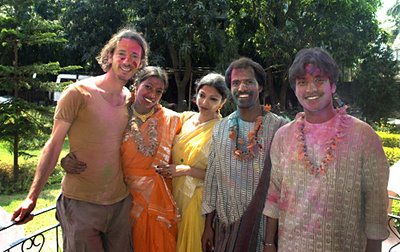
I met and became friends with these great people, amazing dancers. I am wearing what was once a white shirt.


==============
On this note, please take a few minutes to educate yourself as to what the current administration is trying to do to regulate the personal and small-scale keeping of animals. They are wanting to make it illegal to have an animal without a license and probably a computer chip inserted into the animal. This not only affects your personal freedoms but hurts the small-scale industries that deal with locally produced animal products – like fresh milk! Please see these sites for more information: http://NoNAIS.org
Read the USDA's "Draft Program Standards" & "Draft Stratigic Plan" at http://www.animalid.aphis.usda.gov/ on the web. You will see that this plan was developed by the livestock "industry" and RFID tag equipment companies.
A letter or two to your local newspaper and politicians (sample letters available) can ensure that this measure does not gather any more momentum in your state. It has, I am told, already been passed in some states.

Everything you need to know about Indian symbols and culture, available now, signed, sealed, packaged, and delivered! Call 1-800-555-1212 (ask for: Krishna Krishna Hari Ram). Only $29.95 (for each of the ten installments). Call now!
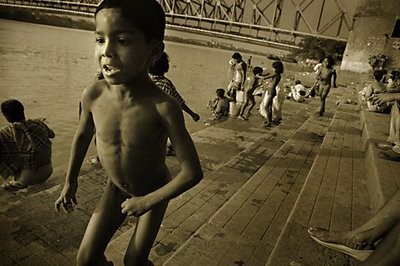
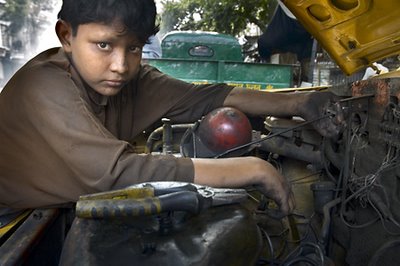
As I move my body from place to place, my mind takes up new residences also. I open these questions of possibility and being the person I am, I sometimes come up with a plan. I’ll open a school that will board those populations with the least opportunity for social change it will be for those seen as poor, backwards, and illiterate. This renaissance school will cultivate a garden of forward thinking individuals. Everything will be provided for the students.
This will be a place where young women and men can celebrate life through language, art, and sustainable living practices. The core threads that will support this growth will be music, dance, drama, drawing, film, science and math, business and accounting, world religions and philosophies, conflict resolution, public speaking. Daily yoga and meditation, organic farming. Small classes, most everything will be hands-on or group discussion. Students will be able to speak and write in their local language, the national language, English, and an additional language. Cooking. Classes will be taught in 2-3 hour blocks for course lengths of 2-3 months. Open air yoga, dance, and meditation rooms. Students will be well-fed with delicious self-harvested foods.
This school will be from 9-6, six days a week since it’s been shown that children learn better starting later in the morning, because they will be living at the school, and because school will be so cool. Throughout the day there will be many opportunities for physical, spiritual, and mental growth. And because sustainable living practices will be one of the core themes of the school, students will be innovating, designing, and building their work and living spaces, planning, planting, and harvesting their foods, constructing energy and irrigation systems. And in all of this, students will practice sowing these seeds throughout neighboring communities in student-led seminars and adult education classes. Imagine adults learning from children!
I think to begin with, great teachers will be lined up to be part of this school. India Corps and Peace Corps workers may also want to be part of the running of the school. I want to go to this school!
Of course there are lots more but imagine an education that can transform the lives of children who work all day with gunpowder on their hands making fireworks so that their families have a few more rupees than they would if the children were to go to school. I would make it worth the family’s while with fresh organically grown boxes of foods that the students have learned to grow and harvest through the most current techniques of biofertilizers, permaculture, and biodynamics. Teachers will know their field and be committed to learning other ones so that the web becomes stronger in their own lessons.
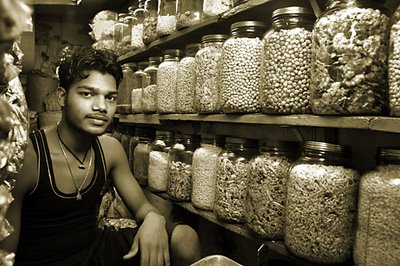
I can see this kind of school being successful in many different places, focusing on each region’s unique biogeography. Imagine a place where learning happens where the students and the teachers eat good foods, exercise, cultivate a quietness of the mind, and learn practical skills that will assist them to be not only productively creative members of a new kind of society but real renaissance individuals that can catalyze a new future for humanity. Wow, that’s going to be a lot of work! But it sounds fun doesn’t it?!
On other days, I just think about moving out to the Pacific coast in the Northwest and opening up a milk bar (that also serves Indian sweets!).


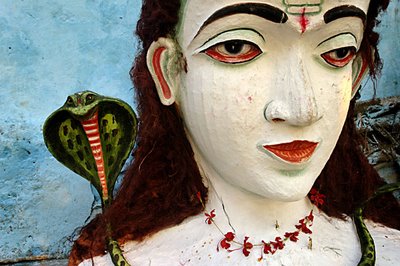
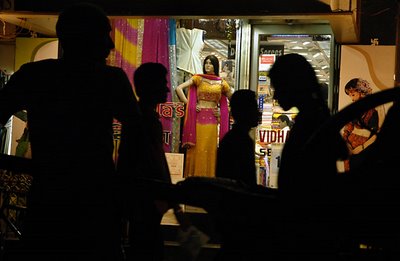
 Before the sun rises, before the moon has set, the men and women that farm the rivers and seas are starting the second part of their day. Men who have been out at sea or far down the rivers, working hard for days, are arriving in port with their catch.
Before the sun rises, before the moon has set, the men and women that farm the rivers and seas are starting the second part of their day. Men who have been out at sea or far down the rivers, working hard for days, are arriving in port with their catch.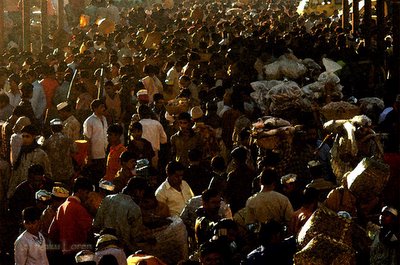 Boats are unloaded by hand, the fish are loaded into trucks that bring the catch into the "hive." As the loaded-down trucks slowly ply through the crowds, their beds are filled with the fish in crushed ice, wicker baskets are busily filled-up by waiting coolies. These delivery boys carry the heavy loads throughout the market to the next intermediary who weigh the fish, scribbling the notes from each delivery into their ledgers. Moments later, the fish are piled back into the baskets and brought to other people who may prepare the fish, deliver the fish further afar, or to the salesmen and women who hawk it right there in the open air market to the general public who prefer to buy their animal meat as fresh and as close to the source as possible.
Boats are unloaded by hand, the fish are loaded into trucks that bring the catch into the "hive." As the loaded-down trucks slowly ply through the crowds, their beds are filled with the fish in crushed ice, wicker baskets are busily filled-up by waiting coolies. These delivery boys carry the heavy loads throughout the market to the next intermediary who weigh the fish, scribbling the notes from each delivery into their ledgers. Moments later, the fish are piled back into the baskets and brought to other people who may prepare the fish, deliver the fish further afar, or to the salesmen and women who hawk it right there in the open air market to the general public who prefer to buy their animal meat as fresh and as close to the source as possible. 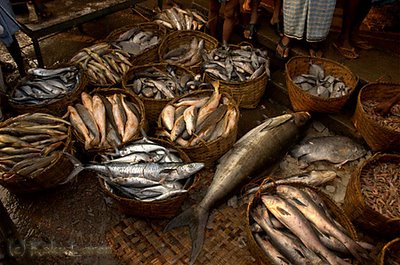
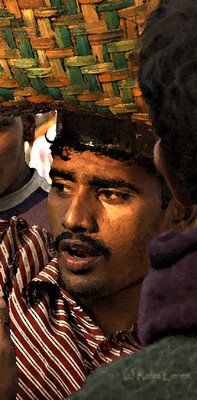 It's not uncommon to see men carrying bamboo sticks which they use on the children as if they were cattle.
It's not uncommon to see men carrying bamboo sticks which they use on the children as if they were cattle. the wheat grain is weighed before the jute bag is sewn up
the wheat grain is weighed before the jute bag is sewn up
Because so much trade and goods transportation is by boat, the workers along the docks are some of the cornerstones for the country's own sustainability. The days are long, the work is arduous, and the pay is barely enough to get to the next day. In these photographs, workers bag and remove the grain of Russian wheat, bringing it to trucks who will then distribute it throughout the country.
 standing deep in wheat, workers fill bags with the grain beofre they are weighed.
standing deep in wheat, workers fill bags with the grain beofre they are weighed.
For more images, visit this gallery.
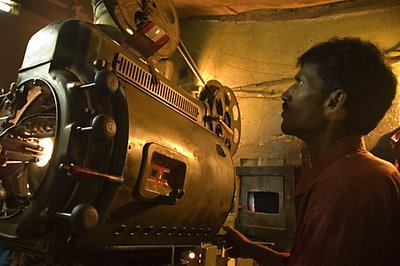

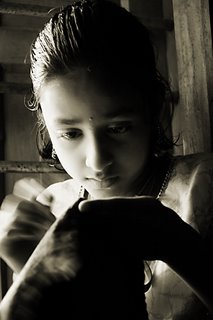 neighboring building. Each dwelling is faintly illuminated from the inside, each rooftop another world of custom and culture but I know there is a thread between my world and theirs. It’s the listening to the cawing birds and irate monkeys, it’s the smells of kitchens that waft spice and aromatic delights with the shifting breezes in the early evenings.
neighboring building. Each dwelling is faintly illuminated from the inside, each rooftop another world of custom and culture but I know there is a thread between my world and theirs. It’s the listening to the cawing birds and irate monkeys, it’s the smells of kitchens that waft spice and aromatic delights with the shifting breezes in the early evenings. It’s the juice-man’s smile and it’s the guard in front of the bank in his overly official looking uniform that sits unmoved hour after hour whilst busses and taxis blare horns and cough exhaust just meters away. Unflinching, he’s completely absorbed, dissecting every bit of his newspaper. And the neighbors who I sometimes see on the roof of the next door building and sometimes down below on the street, sitting, talking, gossiping, as their children run in circles, laughing. It’s seeing these people each day and our brief expressions of communion through words and gestures that help take the edge off being alone – or at least feeling that way most of the time.
It’s the juice-man’s smile and it’s the guard in front of the bank in his overly official looking uniform that sits unmoved hour after hour whilst busses and taxis blare horns and cough exhaust just meters away. Unflinching, he’s completely absorbed, dissecting every bit of his newspaper. And the neighbors who I sometimes see on the roof of the next door building and sometimes down below on the street, sitting, talking, gossiping, as their children run in circles, laughing. It’s seeing these people each day and our brief expressions of communion through words and gestures that help take the edge off being alone – or at least feeling that way most of the time.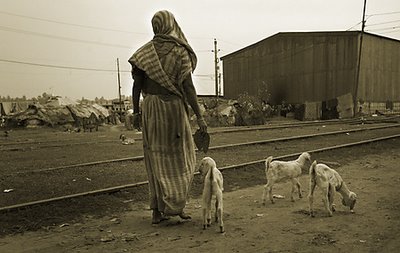 A woman singing with her harmonium and there is no place that I would rather be than across this bit of still air and flowers of jasmine. And then there are the children that dance small homemade kites from rooftops from here all the way to the horizon that create a sea of birds in the orange hazy fire of a big setting sun.
A woman singing with her harmonium and there is no place that I would rather be than across this bit of still air and flowers of jasmine. And then there are the children that dance small homemade kites from rooftops from here all the way to the horizon that create a sea of birds in the orange hazy fire of a big setting sun.